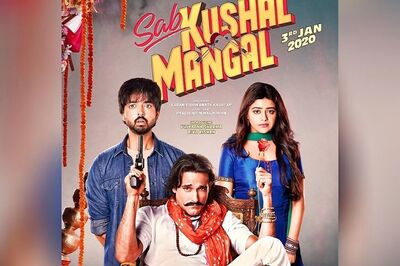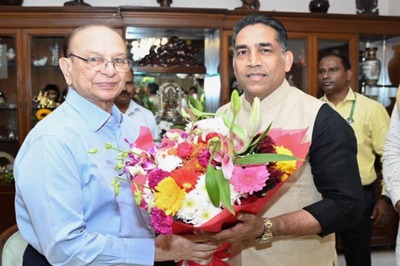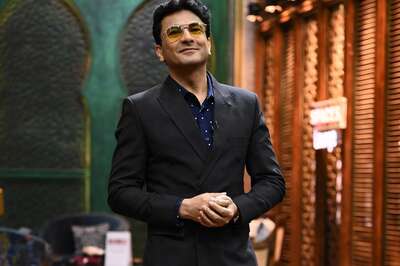
views
A frustrated youth. His love-life dead. His life in shambles. One man responsible. He sends him flowers. Makes him understand. Bad guy has a change of heart. The End.
So what was the difference? One used the gun: the other used Gandhi. But what was common? Both garnered audience applause and box-office moolah.
2006 will be remembered among other things, as a year that gave us both Rang de Basanti and Lage Raho Munnabhai. Two completely opposite films. Opposite ideologies. Opposite paths. Opposite ends. And yet, both were equally lapped up. A startling testament to the fact that in our country today, both the gun and Gandhi find equal support.
RDB of course is much more complex of the two. Despite its resounding success many people had issues with the path of violence it suggested. Many have called it a highly irresponsible film. The most common criticism was that the killing of the Defence Minister was not justified since the students had no real evidence against him. I personally found the character-transitions jarring. One moment they are talking and thinking about patriotism and the next moment they are partying and boozing. What would have helped the cause of the violence was a little more perspective on their part. Also the cause was more personal than national. Then again the real revolutionaries of today's India are very different. What makes the film is the college activism it propagates. It storms the Bastille of college-complacency and tries to jolt students to the harsher realities around.
LRM of course poles apart. It made Gandhigiri cool. Its heart-warming effect notwithstanding it was critiqued for being too simplistic and spreading a message that has been rendered obsolete today. Also many pointed out that one could fight off the Brits with Satyagraha but how can we possibly fight our own people?
Both the films remind one of those two opposite camps in Indian History - the Moderates and the Extremists. Both fought for the same cause but their methodologies were diametrically opposite. The ends were same but the means were different. While the Moderates believed in sending petitions, holding discussions and peaceful demonstrations, the Extremists believed in creating terror in the heart of the Regime through assassinations and secret societies. Both the groups had their steadfast loyalists and staunch critics. Even today the who-was-better debate rages on in political circles and history classrooms. One can safely say that opinions are sharply divided.
And in spite of being poles apart, both the films laughed their way to the bank. This brings us to a significant question. Was it the same audience which first cried its heart out for DJ and gang and then choked with laughter at Munna's Gandhigiri? Or was it a one set of audience which endorsed RDB's violence and a completely different set of audience which supported Munnabhai's Satyagraha? This perhaps is one of the lesser known perils of having such a large population. You are faced with such tricky questions. And you may have no answers.
If it was the same audience then that that would be very interesting. It means we Indians are a flexible lot. We like both. We are large-hearted. We can accommodate both the gun and Gandhi within us. We can support both ideologies as and when the occasion arises. We have a single large mind with enough room for the two. Or it may mean we are a fickle-minded nation that can't decide. A group unable to take a stand. A nation that gets easily swayed whenever either of the ideologies are craftily packaged and presented. If it were two different sets of audiences, which supported the two different ideologies, then we have a potentially dangerous situation. We are a country sharply divided. We are two factions against each other, both equally strong and large. We are a nation, which has kept both the gun and Gandhi alive albeit in two different camps. We have here, two contrasting mindsets alive and poised against each other. Waiting. Watching. Or perhaps it all means something totally different. That we are a nation for which neither really matters. We just go to theatre, have a good time and then forget all about it. And which of all these is the best way? Is there a best way at all?
Different people will have different views. But what was important was this interesting phenomenon. While the debate continues, both the films go down in history. Like the Moderates and the Extremists. And offer more questions than answers.
first published:October 27, 2006, 12:37 ISTlast updated:October 27, 2006, 12:37 IST
window._taboola = window._taboola || [];_taboola.push({mode: 'thumbnails-mid-article',container: 'taboola-mid-article-thumbnails',placement: 'Mid Article Thumbnails',target_type: 'mix'});
let eventFire = false;
window.addEventListener('scroll', () => {
if (window.taboolaInt && !eventFire) {
setTimeout(() => {
ga('send', 'event', 'Mid Article Thumbnails', 'PV');
ga('set', 'dimension22', "Taboola Yes");
}, 4000);
eventFire = true;
}
});
window._taboola = window._taboola || [];_taboola.push({mode: 'thumbnails-a', container: 'taboola-below-article-thumbnails', placement: 'Below Article Thumbnails', target_type: 'mix' });Latest News
A frustrated youth. His friend dead. His life in shambles. One man responsible. He picks up a revolver. Shoots him to death. The End.
A frustrated youth. His love-life dead. His life in shambles. One man responsible. He sends him flowers. Makes him understand. Bad guy has a change of heart. The End.
So what was the difference? One used the gun: the other used Gandhi. But what was common? Both garnered audience applause and box-office moolah.
2006 will be remembered among other things, as a year that gave us both Rang de Basanti and Lage Raho Munnabhai. Two completely opposite films. Opposite ideologies. Opposite paths. Opposite ends. And yet, both were equally lapped up. A startling testament to the fact that in our country today, both the gun and Gandhi find equal support.
RDB of course is much more complex of the two. Despite its resounding success many people had issues with the path of violence it suggested. Many have called it a highly irresponsible film. The most common criticism was that the killing of the Defence Minister was not justified since the students had no real evidence against him. I personally found the character-transitions jarring. One moment they are talking and thinking about patriotism and the next moment they are partying and boozing. What would have helped the cause of the violence was a little more perspective on their part. Also the cause was more personal than national. Then again the real revolutionaries of today's India are very different. What makes the film is the college activism it propagates. It storms the Bastille of college-complacency and tries to jolt students to the harsher realities around.
LRM of course poles apart. It made Gandhigiri cool. Its heart-warming effect notwithstanding it was critiqued for being too simplistic and spreading a message that has been rendered obsolete today. Also many pointed out that one could fight off the Brits with Satyagraha but how can we possibly fight our own people?
Both the films remind one of those two opposite camps in Indian History - the Moderates and the Extremists. Both fought for the same cause but their methodologies were diametrically opposite. The ends were same but the means were different. While the Moderates believed in sending petitions, holding discussions and peaceful demonstrations, the Extremists believed in creating terror in the heart of the Regime through assassinations and secret societies. Both the groups had their steadfast loyalists and staunch critics. Even today the who-was-better debate rages on in political circles and history classrooms. One can safely say that opinions are sharply divided.
And in spite of being poles apart, both the films laughed their way to the bank. This brings us to a significant question. Was it the same audience which first cried its heart out for DJ and gang and then choked with laughter at Munna's Gandhigiri? Or was it a one set of audience which endorsed RDB's violence and a completely different set of audience which supported Munnabhai's Satyagraha? This perhaps is one of the lesser known perils of having such a large population. You are faced with such tricky questions. And you may have no answers.
If it was the same audience then that that would be very interesting. It means we Indians are a flexible lot. We like both. We are large-hearted. We can accommodate both the gun and Gandhi within us. We can support both ideologies as and when the occasion arises. We have a single large mind with enough room for the two. Or it may mean we are a fickle-minded nation that can't decide. A group unable to take a stand. A nation that gets easily swayed whenever either of the ideologies are craftily packaged and presented. If it were two different sets of audiences, which supported the two different ideologies, then we have a potentially dangerous situation. We are a country sharply divided. We are two factions against each other, both equally strong and large. We are a nation, which has kept both the gun and Gandhi alive albeit in two different camps. We have here, two contrasting mindsets alive and poised against each other. Waiting. Watching. Or perhaps it all means something totally different. That we are a nation for which neither really matters. We just go to theatre, have a good time and then forget all about it. And which of all these is the best way? Is there a best way at all?
Different people will have different views. But what was important was this interesting phenomenon. While the debate continues, both the films go down in history. Like the Moderates and the Extremists. And offer more questions than answers.



















Comments
0 comment